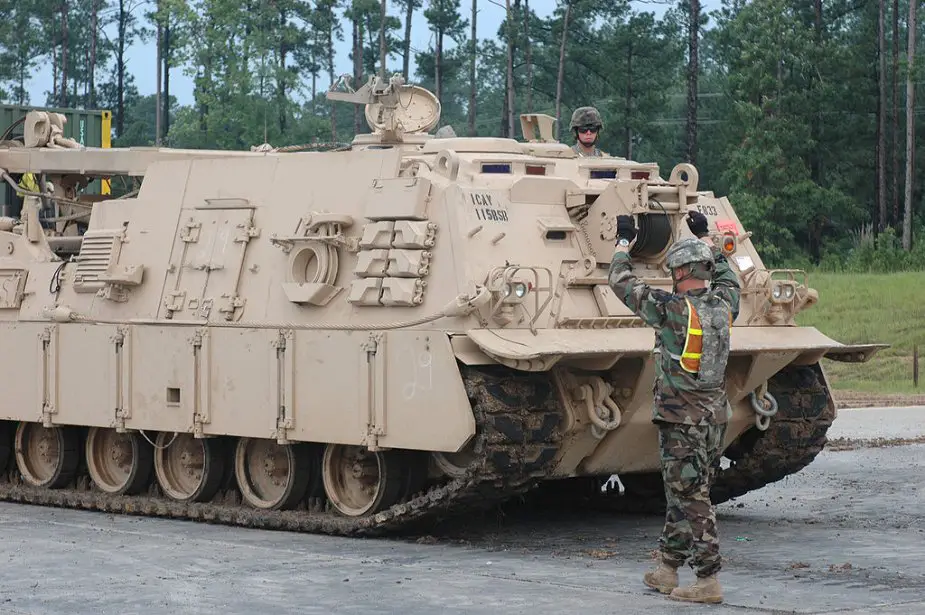BAE Systems has been awarded a $127,588,892 modification to contract W56HZV-17-C-0242 for the sole source procurement of M88A2 HERCULES Heavy Equipment Recovery Combat Utility Lift and Evacuation System vehicles.
Follow Army Recognition on Google News at this link

U.S. Army M88A2 Hercules at a facility in Fort Polk, Louisiana in June 2006 (Picture source: U.S. Army)
Work will be performed in York, Pennsylvania, with an estimated completion date of July 31, 2023. Fiscal 2020 other procurement, Army funds in the amount of $127,588,892 were obligated at the time of the award. U.S. Army Contracting Command, Detroit Arsenal, Michigan, is the contracting activity.
The M88 Recovery Vehicle is one of the largest armored recovery vehicles (ARV) currently in use by the U.S. Armed Forces. There are currently three variants, the M88, M88A1 and M88A2 HERCULES (Heavy Equipment Recovery Combat Utility Lifting Extraction System). The design of this vehicle was based on the chassis and parts of the automotive component of the M48 Patton and M60 Patton tanks. The original M88 was introduced in 1961, M88A1 in 1977, with the current M88A2 introduced in 1997. Originally manufactured by Bowen McLaughlin York (later the BMY division of Harsco Corporation) in 1961, the company would later merge with FMC Corp. to form the United Defense Industries in 1994, which was in turn acquired by BAE Systems in 2005 to become BAE Systems Land and Armaments. In February 2008 the company was awarded a $185 million contract modification from the U.S. Army to manufacture 90 Army-configured M88A2s, four United States Marine Corps-configured M88A2s and authorized spares list parts.

U.S. Marines use an M88A1 to load a Honeywell AGT1500 gas turbine engine back into an M1A1 Abrams at Camp Coyote, Kuwait, in February 2003 (Picture source: U.S. Army)
The M88's primary role is to repair or replace damaged parts in fighting vehicles while under fire, as well as extricate vehicles that have become bogged down or entangled. The main winch on the M88A2 is capable of a 70-ton, single line recovery, and a 140-ton 2:1 recovery when used with the 140 ton pulley. The A-frame boom of the A2 can lift 35 tons when used in conjunction with the spade down. The spade can be used for light earth moving, and can be used to anchor the vehicle when using the main winch. The M88 employs an Auxiliary power unit (APU) to provide auxiliary electrical and hydraulic power when the main engine is not in operation. It can also be used to slave start other vehicles, provide power for the hydraulic impact wrench, as well as the means to refuel or de-fuel vehicles as required. The M88 series of vehicles can refuel M1 Abrams tanks from its own fuel tanks, but this is a last resort due to the possibility of clogging the AGT-1500s fuel filters. The fuel pump draws fuel from the bottom of the fuel cell, and with it, all of the sediment that has accumulated with time.
All variants retain an M2 Browning .50 caliber machine gun, 432 mm ground clearance, 2.6 m fording depth, 1.1 m wall climb and 2.6 m trench crossing capabilities. There has been no major deviation in battlefield role through the M88 series, the later models are merely able to lift heavier loads. The M88A1 was designed around the now obsolete M60 Patton tanks, so it was in light of the fact that two M88A1s were required to tow the new M1 Abrams tank that the decision was made to upgrade to the M88A2 in 1991.

Soldiers of Task Force 1-77 Armor Battalion using an M88 to build "Observation Point Tiger" in Ramadi, Iraq. Notice the added turret to protect the crew member in charge of operating the .50 machine gun (Picture source: U.S. Army)














